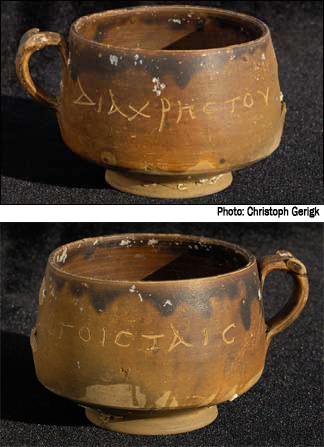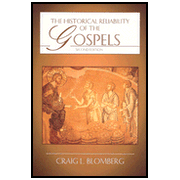Jesus the Magician? Archaeological Find is Unlikely as Earliest Reference to Jesus Christ
Underwater find
A bowl newly discovered in Alexandria, Egypt, and dated to the period from the late second century BCE to the early first century CE bears an engraving  that may be the world’s earliest known reference to Jesus Christ. The engraving reads dia chrstou o goistais, translated by the excavation team as “through Christ the magician.” According to French marine archaeologist Franck Goddio, co-founder of the Oxford Center of Maritime Archaeology, and Egyptologist David Fabre, the phrase could very well be a reference to Jesus Christ, since he was one known as a primary exponent of white magic.
that may be the world’s earliest known reference to Jesus Christ. The engraving reads dia chrstou o goistais, translated by the excavation team as “through Christ the magician.” According to French marine archaeologist Franck Goddio, co-founder of the Oxford Center of Maritime Archaeology, and Egyptologist David Fabre, the phrase could very well be a reference to Jesus Christ, since he was one known as a primary exponent of white magic.
The team found the bowl during their underwater excavation of the ancient harbor of Alexandria. They speculate that a first-century magus may have used the bowl to tell fortunes. They note that the bowl is very similar to one depicted on two early Egyptian statuettes that are thought to show a soothsaying ritual. Ancient soothsaying manuals describe a technique in which the fortune teller poured oil into water and then entered an ecstatic state while studying the whirling mix. In the hallucinatory state, the fortune-teller hoped to meet mystical beings that could field questions about the future. The inscription, the archaeologists theorize, may have served to legitimize the soothsaying by invoking the name of Christ, acknowledged to be a wonder-worker.
How weighty is the evidence?
• Is it "Christ" or "Good"? – The archaeologists may have mistaken one Greek word for another in their interpretation. A glance at the photograph of the cup reveals a letter between the rho ("P") and the sigma ("C"). The letter, though poorly formed, seems unmistakably the letter eta ("H"). If this identification is correct, then the lexical form of the Greek word inscribed is not christos, but chrēstos, meaning "kind, loving, good, merciful."
The prepositional phrase, then, probably indicates that the bowl was a gift, given "through kindness" from some benefactor. It seems obvious that chrēstou is much more likely than christou for the engraved word. Rather than referring to the power of Christ, the word chrēstou might be a reference to the person who gave the cup as a gift—as we might write on a gift “from Donald with best wishes.” This explanation seems as plausible as its alternative is unlikely.
• References to christos too vague to reach certainty – Yet even if christou is the correct word, we are still far from reaching certainty that it is a reference to Jesus Christ. We must remember that the word christos was not a personal name of Jesus but a title, the Greek translation of the Hebrew word mashiach ("Messiah, anointed one"). Like its Hebrew counterpart, this Greek term could apply to any number of people. It occurs in the Hebrew Scriptures more than 60 times, designating priests, prophets, and kings, as well as the anticipated Messiah. It even describes the pagan ruler Cyrus of Persia (Isa. 45:1, LXX). Calling someone christos does not necessarily identify that person with Jesus. Even the Greek Scriptures warn that many would claim that title (Mark 13:21-22).
• The meaning of goistais – In Theological Dictionary of New Testament, Gerhard Delling defines goēs, the lexical form behind goistais, as “imposter, charlatan, one who performs magic through formulae.” Its only New Testament occurrence is in 2 Timothy 3:13: “…evil men and imposters will go from bad to worse, deceiving and being deceived.” Delling says that among ancient people, those who believed in demon possession tended to hold the goēs in high respect, while the educated people tended to look down on such a person. (See also the entry for goēs in the Liddell-Scott-Jones lexicon, which defines it as "sorcerer, wizard" and secondarily as "juggler, cheat.")
If this term goistais, therefore, were a reference to Jesus Christ, it would be most inappropriate. Jesus did not perform miracles through such formulae as abracadabra, alacazam, or presto. When He did speak, he gave simple commands, such as “Be healed!” or “Rise and walk!” Even the words ephphatha and talitha koum of Mark 5:41 and 7:34, respectively, are merely “Be opened!” and “Little girl, I say to you, get up!”, spoken in Aramaic, Jesus’ native tongue. Rather than using formulae, Jesus constantly varied the means by which he healed people—sometimes touching (e.g., Mark 1:31), or saying a few words (e.g., Mark 2:11), or healing without touch (e.g., Matthew 12:13) or even without being present (e.g., Mark 8:13). Some scholars believe He probably varied His healing procedures for the very purpose of avoiding magical associations.
The archaeologists have apparently forced their translation, as if goistais is genitive singular, like chrēstou, and functions in the phrase as an appositive. Goistais, however, is dative plural, making their suggested translation impossible. The phrase dia chrēstou goistais probably means "[Given] through kindness for the magicians."
• The dating is probably too early – At the time of Jesus, tens of centuries before the printing press, and two millennia before the digital age with its instant communication, events in one part of the empire often had little impact beyond the immediate vicinity. For the ripple effect of the ministry of Jesus to reach Alexandria would take some years, and at first would be felt only in Christian and then Jewish circles. For it to sweep across to pagans like the owner of the soothsayer's bowl would take even longer. And not only would the magician have to know of the miraculous power, but enough time would have to elapse for to convince him or her that customers would also be aware of Jesus.
Yet the latest date assigned for the bowl is the early first century. Given that the crucifixion and resurrection of Christ happened no earlier than 30 CE, that only allows 20 years before we reach mid-century. One hundred years or even more might be needed for the ripple to flood the pagan consciousness of Alexandria.
What can we conclude?
If the engraving did refer to Jesus Christ, it would constitute an extrabiblical confirmation that Jesus was a miracle-worker. This is similar to the impact of what is now known as the Paris Magical Papyrus, dated to about 300 CE. It describes an elaborate exorcism ritual, which begins, “I adjure you by the god of the Hebrews,” and then lists a number of mystical names, of which Jesu is the first. The adjuration continues with numerous references to biblical events and persons, some of which are garbled. The point for New Testament studies is the confirmation that in Egypt about 150 years after the resurrection, Jesus was known as a successful exorcist and called “the god of the Hebrews.” This latest discovery would make a similar argument from evidence much, much earlier.
Such evidence opposes against claims skeptics have made for generations that Jesus' miracles all have rationalistic explanations. The eyewitnesses found sufficient proof in Jesus' works to discern the all-powerful hand of God. In the words of the Apostle Peter, Jesus "went around doing good and healing all who were under the power of the devil, because God was with Him" (Acts 10:38). Even if legitimate, this evidence would not constitute proof that Jesus was a magician, despite the claims of such books as Jesus the Magician: Charlatan or Son of God? by Morton Smith, published in 1978. (See Barry Crawford’s largely negative review, published in the Journal of the American Academy of Religion [10/26/1978].)
The problem, however, is that the evidence is too early and that it is too ambiguous to be credible. It seems to be another example of archaeologists attempting to grab headlines by placing their latest discovery in the same sentence with the words “Jesus Christ.” Such unwarranted coupling often contributes to unjustified conclusions about Jesus among the ignorant and the credulous.
NOTE: The Franck Goddio Society has responded to this blog.
Want to Go Deeper?
Recommended for purchase (at discount)
Howard Clark Kee. What Can We Know About Jesus? Cambridge, 1990. – Explores both the biblical accounts of Jesus' life and works and the extrabiblical material touching on this. Extrabiblical references to Christ include the writings of non-orthodox Christians, pagan authors, and Jews. Kee analyzes all the relevant material to determine what precisely can be deduced about Jesus from these diverse accounts, written by both friend and foe.
 Craig L. Blomberg. The Historical Reliability of the Gospels. 2nd ed. Inter-Varsity, 2008. – Reveals the faulty analysis and presuppositions that have led to mistaken conclusions about the Gospels, providing scholarly criteria for judging these books and biblical answers to our hard questions. Thoroughly updated in light of new developments. Readers will find that over the past twenty years, the case for the historical trustworthiness of the Gospels has grown vastly stronger.
Craig L. Blomberg. The Historical Reliability of the Gospels. 2nd ed. Inter-Varsity, 2008. – Reveals the faulty analysis and presuppositions that have led to mistaken conclusions about the Gospels, providing scholarly criteria for judging these books and biblical answers to our hard questions. Thoroughly updated in light of new developments. Readers will find that over the past twenty years, the case for the historical trustworthiness of the Gospels has grown vastly stronger.
C. K. Barrett. The New Testament Background. HarperOne, 1989. Contains a discussion of the Paris Magical Papyrus along with its text in English translation (pp. 34ff). Also contains a wealth of other material relevant to New Testament studies.
Recommended for online reading
Details about the Paris Magical Papyrus in G. A. Deissmann, Light from the Ancient East. Hodder & Stoughton, 1910. pp. 254ff.
Gary R. Habermas, The Late Twentieth-Century Resurgence of
Naturalistic Responses to Jesus' Resurrection. Trinity Journal, 2001.
Larry W. Hurtado, Lord Jesus Christ. Eerdmans, 2005. – A short discussion of the title “Christ” (“Messiah”).
You may want to study the earliest charge that Jesus was a magician, leveled by the anti-Christian debater Celsus in the third century. The church father Origen ably defended the orthodox view by pointing out that in contrast to magicians, Jesus' miracles all had a moral purpose. See Origen, Against Celsus, book 1, chapter 68. In the century before, Justin Martyr anticipated such a charge in his First Apology, chapter 30.
If you are curious about Morton’s Smith’s book, take a look at the exchange Professor Smith had with Frank Kermode over the latter’s review of Smith’s book in the New York Review of Books. This exchange includes a summary of Smith’s main points and the essentials of Kermode’s critique. Be sure to read all four essays, the first two published on Dec. 21, 1978, and the second on Feb. 8, 1979. Unfortunately, the original review is unavailable without a subscription to the Review. Here is a brief review by Terrance Callan from the Library Journal (June 15, 1978).
Steve Singleton, DeeperStudy.com
» Post a Comment